Netfilter - ACLs
Netfilter is the packet filtering framework in Cumulus Linux and most other Linux distributions. There several tools available for configuring ACLs in Cumulus Linux:
iptables,ip6tables, andebtablesare Linux userspace tools used to administer filtering rules for IPv4 packets, IPv6 packets, and Ethernet frames (layer 2 using MAC addresses).cl-acltoolis a Cumulus Linux-specific userspace tool used to administer filtering rules and configure default ACLs.cl-acltooloperates on various configuration files and usesiptables,ip6tables, andebtablesto install rules into the kernel. In addition,cl-acltoolprograms rules in hardware for interfaces involving switch port interfaces, whichiptables,ip6tablesandebtablescannot do on their own.
Traffic Rules
Chains
Netfilter describes the way that the Linux kernel classifies and controls packets to, from, and across the switch. Netfilter does not require a separate software daemon to run; it is part of the Linux kernel itself. Netfilter asserts policies at layer 2, 3 and 4 of the OSI model by inspecting packet and frame headers according to a list of rules. The iptables, ip6tables, and ebtables userspace applications provide syntax you use to define rules.
The rules inspect or operate on packets at several points (chains) in the life of the packet through the system:

- PREROUTING touches packets before the switch routes them
- INPUT touches packets after the switch determines that the packets are for the local system but before the control plane software receives them
- FORWARD touches transit traffic as it moves through the switch
- OUTPUT touches packets from the control plane software before they leave the switch
- POSTROUTING touches packets immediately before they leave the switch but after a routing decision
Tables
When you build rules to affect the flow of traffic, tables can access the individual chains. Linux provides three tables by default:
- Filter classifies traffic or filters traffic
- NAT applies Network Address Translation rules
- Mangle alters packets as they move through the switch
Each table has a set of default chains that modify or inspect packets at different points of the path through the switch. Chains contain the individual rules to influence traffic. The figure below shows each table and the default chains they support. Cumulus Linux supports the tables and chains in green. Cumulus Linux does not support the tables and chains in red.
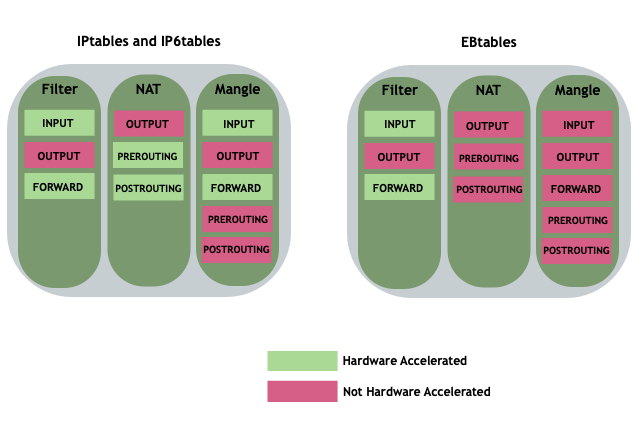
Rules
Rules classify the traffic you want to control. You apply rules to chains, which attach to tables.
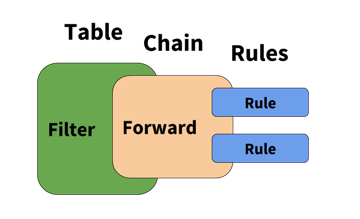
Rules have several different components:
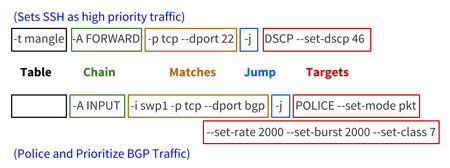
- Table: The first argument is the table. The second example does not specify a table; the filter table is the default.
- Chain: The second argument is the chain. Each table supports several different chains. See Tables above.
- Matches: The third argument is the match. You can specify multiple matches in a single rule. However, the more matches you use in a rule, the more memory the rule consumes.
- Jump: The jump specifies the target of the rule; what action to take if the packet matches the rule. If you omit this option in a rule, matching the rule has no effect on the packet, but the counters on the rule increment.
- Targets: The target is a user-defined chain (other than the one this rule is in), one of the special built-in targets that decides the fate of the packet immediately (like DROP), or an extended target. See Supported Rule Types below for different target examples.
How Rules Parse and Apply
The switch reads all the rules from each chain from iptables, ip6tables, and ebtables and enters them in order into either the filter table or the mangle table. The switch reads the rules from the kernel in the following order:
- IPv6 (
ip6tables) - IPv4 (
iptables) ebtables
When you combine and put rules into one table, the order determines the relative priority of the rules; iptables and ip6tables have the highest precedence and ebtables has the lowest.
The Linux packet forwarding construct is an overlay for how the silicon underneath processes packets. Be aware of the following:
The switch silicon reorders rules when
switchdwrites to the ASIC, whereas traditionaliptablesexecute the list of rules in order.All rules, except for POLICE and SETCLASS rules, are terminating; after a rule matches, the action occurs and no more rules process. In the example below, the SETCLASS action with the
--in-interfaceoption creates the internal ASIC classification, and continues to process the next rule, which provides rate-limiting for the matched protocol:-A $INGRESS_CHAIN --in-interface $INGRESS_INTF -p udp --dport $BFD_ECHO_PORT -j SETCLASS --class 7 -A $INGRESS_CHAIN -p udp --dport $BFD_ECHO_PORT -j POLICE --set-mode pkt --set-rate 2000 --set-burst 2000When processing traffic, rules affecting the FORWARD chain that specify an ingress interface process before rules that match on an egress interface. As a workaround, rules that only affect the egress interface can have an ingress interface wildcard (only swp+ and bond+) that matches any interface you apply so that you can maintain order of operations with other input interface rules. For example, with the following rules:
-A FORWARD -i $PORTA -j ACCEPT -A FORWARD -o $PORTA -j ACCEPT <-- This rule processes LAST (because of egress interface matching) -A FORWARD -i $PORTB -j DROPIf you modify the rules like this, they process in order:
-A FORWARD -i $PORTA -j ACCEPT -A FORWARD -i swp+ -o $PORTA -j ACCEPT <-- These rules are performed in order (because of wildcard match on the ingress interface) -A FORWARD -i $PORTB -j DROPWhen using rules that do a mangle and a filter lookup for a packet, Cumulus Linux processes them in parallel and combines the action.
If a switch port has a bond, you must assign any egress rules to the bond.
When using the OUTPUT chain, you must assign rules to the source. For example, if you assign a rule to the switch port in the direction of traffic but the source is a bridge (VLAN), the rule does not affect the traffic and you must apply it to the bridge.
If you need to apply a rule to all transit traffic, use the FORWARD chain, not the OUTPUT chain.
The switch puts
ebtablerules into either the IPv4 or IPv6 memory space depending on whether the rule uses IPv4 or IPv6 to make a decision. The switch only puts layer 2 rules that match the MAC address into the IPv4 memory space.
Rule Placement in Memory
INPUT and ingress (FORWARD -i) rules occupy the same memory space. A rule counts as ingress if you set the -i option. If you set both input and output options (-i and -o), the switch considers the rule as ingress and occupies that memory space. For example:
-A FORWARD -i swp1 -o swp2 -s 10.0.14.2 -d 10.0.15.8 -p tcp -j ACCEPT
If you set an output flag with the INPUT chain, you see an error. For example:
-A FORWARD,INPUT -i swp1 -o swp2 -s 10.0.14.2 -d 10.0.15.8 -p tcp -j ACCEPT
error: line 2 : output interface specified with INPUT chain error processing rule '-A FORWARD,INPUT -i swp1 -o swp2 -s 10.0.14.2 -d 10.0.15.8 -p tcp -j ACCEPT'
If you remove the -o option and the interface, it is a valid rule.
Nonatomic Update Mode and Atomic Update Mode
Cumulus Linux enables atomic update mode by default. However, this mode limits the number of ACL rules that you can configure.
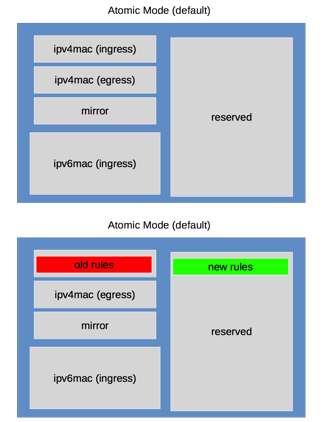
To increase the number of configurable ACL rules, configure the switch to operate in nonatomic mode.
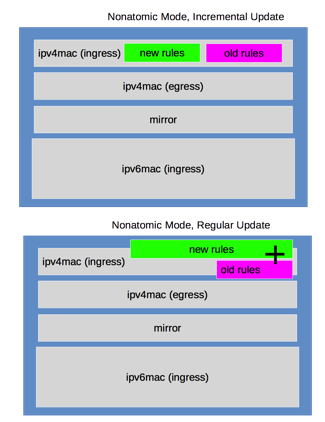
Instead of reserving 50% of your TCAM space for atomic updates, incremental update uses the available free space to write the new TCAM rules and swap over to the new rules after this is complete. Cumulus Linux then deletes the old rules and frees up the original TCAM space. If there is insufficient free space to complete this task, the original nonatomic update runs, which interrupts traffic.
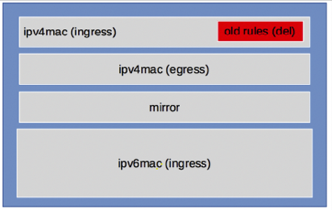
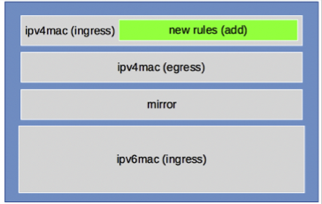
You can enable nonatomic updates for switchd, which offer better scaling because all TCAM resources actively impact traffic. With atomic updates, half of the hardware resources are on standby and do not actively impact traffic.
Incremental nonatomic updates are table based, so they do not interrupt network traffic when you install new rules. The rules map to the following tables and update in this order:
- mirror (ingress only)
- ipv4-mac (can be both ingress and egress)
- ipv6 (ingress only)
The incremental nonatomic update operation follows this order:
- Updates are incremental, one table at a time without stopping traffic.
- Cumulus Linux checks if the rules in a table are different from installation time; if a table does not have any changes, it does not reinstall the rules.
- If there are changes in a table, the new rules populate in new groups or slices in hardware, then that table switches over to the new groups or slices.
- Finally, old resources for that table free up. This process repeats for each of the tables listed above.
- If there are insufficient resources to hold both the new rule set and old rule set, Cumulus Linux tries the regular nonatomic mode, which interrupts network traffic.
- If the regular nonatomic update fails, Cumulus Linux reverts back to the previous rules.
To always start switchd with nonatomic updates:
Edit
/etc/cumulus/switchd.conf.Add the following line to the file:
acl.non_atomic_update_mode = TRUEcumulus@switch:~$ sudo systemctl restart switchd.service
Restarting the
switchdservice causes all network ports to reset, interrupting network services, in addition to resetting the switch hardware configuration.
During regular non-incremental nonatomic updates, traffic stops, then continues after all the new configuration is in the hardware.
iptables, ip6tables, and ebtables
Do not use iptables, ip6tables, ebtables directly; installed rules only apply to the Linux kernel and Cumulus Linux does not hardware accelerate. When you run cl-acltool -i, Cumulus Linux resets all rules and deletes anything that is not in /etc/cumulus/acl/policy.conf.
For example, the following rule appears to work:
cumulus@switch:~$ sudo iptables -A INPUT -p icmp --icmp-type echo-request -j DROP
The cl-acltool -L command shows the rule:
cumulus@switch:~$ sudo cl-acltool -L ip
-------------------------------
Listing rules of type iptables:
-------------------------------
TABLE filter :
Chain INPUT (policy ACCEPT 72 packets, 5236 bytes)
pkts bytes target prot opt in out source destination
0 0 DROP icmp -- any any anywhere anywhere icmp echo-request
However, Cumulus Linux does not synchronize the rule to hardware. Running cl-acltool -i or reboot removes the rule without replacing it. To ensure that Cumulus Linux hardware accelerates all rules that can be in hardware, add them to /etc/cumulus/acl/policy.conf and install them with the cl-acltool -i command.
Estimate the Number of Rules
To estimate the number of rules you can create from an ACL entry, first determine if that entry is an ingress or an egress. Then, determine if it is an IPv4-mac or IPv6 type rule. This determines the slice to which the rule belongs. Use the following to determine how many entries the switch uses for each type.
By default, each entry occupies one double wide entry, except if the entry is one of the following:
An entry with multiple comma-separated input interfaces splits into one rule for each input interface. For example, this entry splits into two rules:
-A FORWARD --in-interface swp1s0,swp1s1 -p icmp -j ACCEPTAn entry with multiple comma-separated output interfaces splits into one rule for each output interface. This entry splits into two rules:
-A FORWARD --in-interface swp+ --out-interface swp1s0,swp1s1 -p icmp -j ACCEPTAn entry with both input and output comma-separated interfaces splits into one rule for each combination of input and output interface This entry splits into four rules:
-A FORWARD --in-interface swp1s0,swp1s1 --out-interface swp1s2,swp1s3 -p icmp -j ACCEPTAn entry with multiple layer 4 port ranges splits into one rule for each range. For example, this entry splits into two rules:
-A FORWARD --in-interface swp+ -p tcp -m multiport --dports 1050:1051,1055:1056 -j ACCEPTYou can only use port ranges for ingress rules.
Install and Manage ACL Rules with NCLU
NCLU provides an easy way to create custom ACLs. The rules you create live in the /var/lib/cumulus/nclu/nclu_acl.conf file, which Cumulus Linux converts to a rules file, /etc/cumulus/acl/policy.d/50_nclu_acl.rules. The rules you create with NCLU are independent of the default files in /etc/cumulus/acl/policy.d/ 00control_plane.rules and 99control_plane_catch_all.rules. If you update the content in these files after a Cumulus Linux upgrade, you do not lose the rules.
Instead of crafting a rule by hand then installing it with cl-acltool, NCLU handles most options automatically. For example, consider the following iptables rule:
-A FORWARD -i swp1 -s 10.0.14.2 -d 10.0.15.8 -p tcp -j ACCEPT
To create this rule with NCLU and call it EXAMPLE1:
cumulus@switch:~$ net add acl ipv4 EXAMPLE1 accept tcp source-ip 10.0.14.2/32 source-port any dest-ip 10.0.15.8/32 dest-port any
cumulus@switch:~$ net pending
cumulus@switch:~$ net commit
NCLU adds all options, such as the -j and -p, even FORWARD in the above rule automatically when you apply the rule to the control plane; NCLU figures it all out for you.
You can also set a priority value, which specifies the order in which the rules execute and the order in which they appear in the rules file. Lower numbers execute first. To add a new rule in the middle, first run net show config acl, which displays the priority numbers. Otherwise, new rules append to the end of the list of rules in the nclu_acl.conf and 50_nclu_acl.rules files.
If you need to edit a rule manually, do not edit the 50_nclu_acl.rules file. Instead, edit the nclu_acl.conf file.
After you add the rule, you need to apply it to an inbound or outbound interface with the net add int acl command. The inbound interface in the following example is swp1:
cumulus@switch:~$ net add int swp1 acl ipv4 EXAMPLE1 inbound
cumulus@switch:~$ net pending
cumulus@switch:~$ net commit
After you commit your changes, verify the rule; run net show configuration acl:
cumulus@switch:~$ net show configuration acl
acl ipv4 EXAMPLEv4 priority 10 accept tcp source-ip 10.0.14.2/32 source-port any dest-ip 10.0.15.8/32 dest-port any
interface swp1
acl ipv4 EXAMPLE1 inbound
To see all installed rules, run cat on the 50_nclu_acl.rules file:
cumulus@switch:~$ cat /etc/cumulus/acl/policy.d/50_nclu_acl.rules
[iptables]
# swp1: acl ipv4 EXAMPLE1 inbound
-A FORWARD --in-interface swp1 --out-interface swp2 -j ACCEPT -p tcp -s 10.0.14.2/32 -d 10.0.15.8/32 --dport 110
For rules affecting the INPUT chain, apply the rule to a control plane interface with net add control-plane:
cumulus@switch:~$ net add control-plane acl ipv4 EXAMPLE1 inbound
cumulus@switch:~$ net pending
cumulus@switch:~$ net commit
The net add control-plane command applies the rule to all data plane ports (swps). To apply the rule to all ports including eth0, run the net add control-plane-all command.
To remove a rule, run net del acl ipv4|ipv6|mac RULENAME. This command deletes all rules from the 50_nclu_acl.rules file with the name you specify. The command also deletes the interfaces referenced in the nclu_acl.conf file.
cumulus@switch:~$ net del acl ipv4 EXAMPLE1
cumulus@switch:~$ net pending
cumulus@switch:~$ net commit
Install and Manage ACL Rules with cl-acltool
You can manage Cumulus Linux ACLs with cl-acltool. Rules write first to the iptables chains, as described above, and then synchronize to hardware through switchd.
To examine the current state of chains and list all installed rules, run:
cumulus@switch:~$ sudo cl-acltool -L all
-------------------------------
Listing rules of type iptables:
-------------------------------
TABLE filter :
Chain INPUT (policy ACCEPT 90 packets, 14456 bytes)
pkts bytes target prot opt in out source destination
0 0 DROP all -- swp+ any 240.0.0.0/5 anywhere
0 0 DROP all -- swp+ any loopback/8 anywhere
0 0 DROP all -- swp+ any base-address.mcast.net/8 anywhere
0 0 DROP all -- swp+ any 255.255.255.255 anywhere ...
To list installed rules using native iptables, ip6tables and ebtables, use the -L option with the respective commands:
cumulus@switch:~$ sudo iptables -L
cumulus@switch:~$ sudo ip6tables -L
cumulus@switch:~$ sudo ebtables -L
To flush all installed rules, run:
cumulus@switch:~$ sudo cl-acltool -F all
To flush only the IPv4 iptables rules, run:
cumulus@switch:~$ sudo cl-acltool -F ip
If the install fails, ACL rules in the kernel and hardware roll back to the previous state. You also see errors from programming rules in the kernel or ASIC.
Install Packet Filtering (ACL) Rules
cl-acltool takes access control list (ACL) rule input in files. Each ACL policy file includes iptables, ip6tables and ebtables categories under the tags [iptables], [ip6tables] and [ebtables]. You must assign each rule in an ACL policy to one of the rule categories.
See man cl-acltool(5) for ACL rule details. For iptables rule syntax, see man iptables(8). For ip6tables rule syntax, see man ip6tables(8). For ebtables rule syntax, see man ebtables(8).
See man cl-acltool(5) and man cl-acltool(8) for more details on using cl-acltool.
By default:
- ACL policy files are in
/etc/cumulus/acl/policy.d/. - All
*.rulesfiles in/etc/cumulus/acl/policy.d/directory are also in/etc/cumulus/acl/policy.conf. - All files in the
policy.conffile install when the switch boots up. - The
policy.conffile expects rule files to have a.rulessuffix as part of the file name.
Here is an example ACL policy file:
[iptables]
-A INPUT --in-interface swp1 -p tcp --dport 80 -j ACCEPT
-A FORWARD --in-interface swp1 -p tcp --dport 80 -j ACCEPT
[ip6tables]
-A INPUT --in-interface swp1 -p tcp --dport 80 -j ACCEPT
-A FORWARD --in-interface swp1 -p tcp --dport 80 -j ACCEPT
[ebtables]
-A INPUT -p IPv4 -j ACCEPT
-A FORWARD -p IPv4 -j ACCEPT
You can use wildcards or variables to specify chain and interface lists.
You can only use swp+ and bond+ as wildcard names.
swp+ rules apply as an aggregate, not per port. If you want to apply per port policing, specify a specific port instead of the wildcard.
INGRESS = swp+
INPUT_PORT_CHAIN = INPUT,FORWARD
[iptables]
-A $INPUT_PORT_CHAIN --in-interface $INGRESS -p tcp --dport 80 -j ACCEPT
[ip6tables]
-A $INPUT_PORT_CHAIN --in-interface $INGRESS -p tcp --dport 80 -j ACCEPT
[ebtables]
-A INPUT -p IPv4 -j ACCEPT
You can write ACL rules for the system into multiple files under the default /etc/cumulus/acl/policy.d/ directory. The ordering of rules during installation follows the sort order of the files according to their file names.
Use multiple files to stack rules. The example below shows two rule files that separate rules for management and datapath traffic:
cumulus@switch:~$ ls /etc/cumulus/acl/policy.d/
00sample_mgmt.rules 01sample_datapath.rules
cumulus@switch:~$ cat /etc/cumulus/acl/policy.d/00sample_mgmt.rules
INGRESS_INTF = swp+
INGRESS_CHAIN = INPUT
[iptables]
# protect the switch management
-A $INGRESS_CHAIN --in-interface $INGRESS_INTF -s 10.0.14.2 -d 10.0.15.8 -p tcp -j ACCEPT
-A $INGRESS_CHAIN --in-interface $INGRESS_INTF -s 10.0.11.2 -d 10.0.12.8 -p tcp -j ACCEPT
-A $INGRESS_CHAIN --in-interface $INGRESS_INTF -d 10.0.16.8 -p udp -j DROP
cumulus@switch:~$ cat /etc/cumulus/acl/policy.d/01sample_datapath.rules
INGRESS_INTF = swp+
INGRESS_CHAIN = INPUT, FORWARD
[iptables]
-A $INGRESS_CHAIN --in-interface $INGRESS_INTF -s 192.0.2.5 -p icmp -j ACCEPT
-A $INGRESS_CHAIN --in-interface $INGRESS_INTF -s 192.0.2.6 -d 192.0.2.4 -j DROP
-A $INGRESS_CHAIN --in-interface $INGRESS_INTF -s 192.0.2.2 -d 192.0.2.8 -j DROP
Install all ACL policies under a directory:
cumulus@switch:~$ sudo cl-acltool -i -P ./rules
Reading files under rules
Reading rule file ./rules/01_http_rules.txt ...
Processing rules in file ./rules/01_http_rules.txt ...
Installing acl policy ...
Done.
Apply all rules and policies included in /etc/cumulus/acl/policy.conf:
cumulus@switch:~$ sudo cl-acltool -i
Specify the Policy Files to Install
By default, Cumulus Linux installs any .rules file you configure in /etc/cumulus/acl/policy.d/. To add other policy files to an ACL, you need to include them in /etc/cumulus/acl/policy.conf. For example, for Cumulus Linux to install a rule in a policy file called 01_new.datapathacl, add include /etc/cumulus/acl/policy.d/01_new.rules to policy.conf:
cumulus@switch:~$ sudo nano /etc/cumulus/acl/policy.conf
#
# This file is a master file for acl policy file inclusion
#
# Note: This is not a file where you list acl rules.
#
# This file can contain:
# - include lines with acl policy files
# example:
# include <filepath>
#
# see manpage cl-acltool(5) and cl-acltool(8) for how to write policy files
#
include /etc/cumulus/acl/policy.d/01_new.datapathacl
Hardware Limitations on Number of Rules
The maximum number of rules that the hardware process depends on:
- The mix of IPv4 and IPv6 rules; Cumulus Linux does not support the maximum number of rules for both IPv4 and IPv6 simultaneously.
- The number of default rules that Cumulus Linux provides.
- Whether the rules apply on ingress or egress.
- Whether the rules are in atomic or nonatomic mode; Cumulus Linux uses nonatomic mode rules when you enable nonatomic updates (see above).
If you exceed the maximum number of rules for a particular table, cl-acltool -i generates the following error:
error: hw sync failed (sync_acl hardware installation failed) Rolling back .. failed.
In the table below, the default rules count toward the limits listed. The raw limits below assume only one ingress and one egress table are present.
The NVIDIA Spectrum ASIC has one common TCAM for both ingress and egress, which you can use for other non-ACL-related resources. However, the number of supported rules varies with the TCAM profile for the switch.
| Profile | Atomic Mode IPv4 Rules | Atomic Mode IPv6 Rules | Nonatomic Mode IPv4 Rules | Nonatomic Mode IPv6 Rules |
|---|---|---|---|---|
| default | 500 | 250 | 1000 | 500 |
| ipmc-heavy | 750 | 500 | 1500 | 1000 |
| acl-heavy | 1750 | 1000 | 3500 | 2000 |
| ipmc-max | 1000 | 500 | 2000 | 1000 |
| ip-acl-heavy | 6000 | 0 | 12000 | 0 |
- Even though the table above specifies the ip-acl-heavy profile supports no IPv6 rules, Cumulus Linux does not prevent you from configuring IPv6 rules. However, there is no guarantee that IPv6 rules work under the ip-acl-heavy profile.
- The ip-acl-heavy profile shows an updated number of supported atomic mode and nonatomic mode IPv4 rules. The previously published numbers were 7500 for atomic mode and 15000 for nonatomic mode IPv4 rules.
Supported Rule Types
The iptables/ip6tables/ebtables construct tries to layer the Linux implementation on top of the underlying hardware but they are not always directly compatible. This section provides the supported rules for chains in iptables, ip6tables and ebtables.
To learn more about any of the options shown in the tables below, run iptables -h [name of option]. The same help syntax works for options for ip6tables and ebtables.
root@leaf1# ebtables -h tricolorpolice
...
tricolorpolice option:
--set-color-mode STRING setting the mode in blind or aware
--set-cir INT setting committed information rate in kbits per second
--set-cbs INT setting committed burst size in kbyte
--set-pir INT setting peak information rate in kbits per second
--set-ebs INT setting excess burst size in kbyte
--set-conform-action-dscp INT setting dscp value if the action is accept for conforming packets
--set-exceed-action-dscp INT setting dscp value if the action is accept for exceeding packets
--set-violate-action STRING setting the action (accept/drop) for violating packets
--set-violate-action-dscp INT setting dscp value if the action is accept for violating packets
Supported chains for the filter table:
INPUT FORWARD OUTPUT
iptables and ip6tables Rule Support
| Rule Element | Supported | Unsupported |
|---|---|---|
| Matches | Src/Dst, IP protocol In/out interface IPv4: icmp, ttl, IPv6: icmp6, frag, hl, IP common: tcp (with flags), udp, multiport, DSCP, addrtype | Rules with input/output Ethernet interfaces do not apply Inverse matches |
| Standard Targets | ACCEPT, DROP | RETURN, QUEUE, STOP, Fall Thru, Jump |
| Extended Targets | LOG (IPv4/IPv6); UID is not supported for LOG TCP SEQ, TCP options or IP options ULOG SETQOS DSCP Unique to Cumulus Linux: SPAN ERSPAN (IPv4/IPv6) POLICE TRICOLORPOLICE SETCLASS |
ebtables Rule Support
| Rule Element | Supported | Unsupported |
|---|---|---|
| Matches | ether type input interface/wildcard output interface/wildcard Src/Dst MAC IP: src, dest, tos, proto, sport, dport IPv6: tclass, icmp6: type, icmp6: code range, src/dst addr, sport, dport 802.1p (CoS) VLAN | Inverse matches Proto length |
| Standard Targets | ACCEPT, DROP | RETURN, CONTINUE, Jump, Fall Thru |
| Extended Targets | ULOG LOG Unique to Cumulus Linux: SPAN ERSPAN POLICE TRICOLORPOLICE SETCLASS |
Unsupported Rules
- Rules that have no matches and accept all packets in a chain are currently ignored.
- Chain default rules (that are ACCEPT) are also ignored.
Splitting Rules Across the Ingress TCAM and the Egress TCAM
Splitting rules across the ingress TCAM and the egress TCAM causes the ingress IPv6 part of the rule to match packets going to all destinations, which can interfere with the regular expected linear rule match in a sequence. For example:
A higher rule can prevent a lower rule from matching:
Rule 1: -A FORWARD --out-interface vlan100 -p icmp6 -j ACCEPT
Rule 2: -A FORWARD --out-interface vlan101 -p icmp6 -s 01::02 -j ACCEPT
Rule 1 matches all icmp6 packets from to all out interfaces in the ingress TCAM.
This prevents rule 2 from matching, which is more specific but with a different out interface. Make sure to put more specific matches above more general matches even if the output interfaces are different.
When you have two rules with the same output interface, the lower rule might match depending on the presence of the previous rules.
Rule 1: -A FORWARD --out-interface vlan100 -p icmp6 -j ACCEPT
Rule 2: -A FORWARD --out-interface vlan101 -s 00::01 -j DROP
Rule 3: -A FORWARD --out -interface vlan101 -p icmp6 -j ACCEPT
Rule 3 still matches for an icmp6 packet with sip 00:01 going out of vlan101. Rule 1 interferes with the normal function of rule 2 and/or rule 3.
When you have two adjacent rules with the same match and different output interfaces, such as:
Rule 1: -A FORWARD --out-interface vlan100 -p icmp6 -j ACCEPT
Rule 2: -A FORWARD --out-interface vlan101 -p icmp6 -j DROP
Rule 2 never matches on ingress. Both rules share the same mark.
Control Plane and Data Plane Traffic
You can configure quality of service for traffic on both the control plane and the data plane. By using QoS policers, you can rate limit traffic so incoming packets get dropped if they exceed specified thresholds.
Counters on POLICE ACL rules in iptables do not show dropped packets due to those rules.
Use the POLICE target with iptables. POLICE takes these arguments:
--set-class valuesets the system internal class of service queue configuration to value.--set-rate valuespecifies the maximum rate in kilobytes (KB) or packets.--set-burst valuespecifies the number of packets or kilobytes (KB) allowed to arrive sequentially.--set-mode stringsets the mode in KB (kilobytes) or pkt (packets) for rate and burst size.
For example, to rate limit the incoming traffic on swp1 to 400 packets per second with a burst of 100 packets per second and set the class of the queue for the policed traffic as 0, set this rule in your appropriate .rules file:
-A INPUT --in-interface swp1 -j POLICE --set-mode pkt --set-rate 400 --set-burst 100 --set-class 0
Here is another example of control plane ACL rules to lock down the switch. You specify the rules in /etc/cumulus/acl/policy.d/00control_plane.rules:
Set DSCP on Transit Traffic
The examples here use the mangle table to modify the packet as it transits the switch. DSCP is in decimal notation in the examples below.
[iptables]
#Set SSH as high priority traffic.
-t mangle -A FORWARD -p tcp --dport 22 -j DSCP --set-dscp 46
#Set everything coming in SWP1 as AF13
-t mangle -A FORWARD --in-interface swp1 -j DSCP --set-dscp 14
#Set Packets destined for 10.0.100.27 as best effort
-t mangle -A FORWARD -d 10.0.100.27/32 -j DSCP --set-dscp 0
#Example using a range of ports for TCP traffic
-t mangle -A FORWARD -p tcp -s 10.0.0.17/32 --sport 10000:20000 -d 10.0.100.27/32 --dport 10000:20000 -j DSCP --set-dscp 34
Verify DSCP Values on Transit Traffic
The examples here use the DSCP match criteria in combination with other IP, TCP, and interface matches to identify traffic and count the number of packets.
[iptables]
#Match and count the packets that match SSH traffic with DSCP EF
-A FORWARD -p tcp --dport 22 -m dscp --dscp 46 -j ACCEPT
#Match and count the packets coming in SWP1 as AF13
-A FORWARD --in-interface swp1 -m dscp --dscp 14 -j ACCEPT
#Match and count the packets with a destination 10.0.0.17 marked best effort
-A FORWARD -d 10.0.100.27/32 -m dscp --dscp 0 -j ACCEPT
#Match and count the packets in a port range with DSCP AF41
-A FORWARD -p tcp -s 10.0.0.17/32 --sport 10000:20000 -d 10.0.100.27/32 --dport 10000:20000 -m dscp --dscp 34 -j ACCEPT
Check the Packet and Byte Counters for ACL Rules
To verify the counters using the above example rules, first send test traffic matching the patterns through the network. The following example generates traffic with mz (or mausezahn), which you can install on host servers or on Cumulus Linux switches. After you send traffic to validate the counters, they match on switch1 using cl-acltool.
Policing counters do not increment on switches with the Spectrum ASIC.
# Send 100 TCP packets on host1 with a DSCP value of EF with a destination of host2 TCP port 22:
cumulus@host1$ mz eth1 -A 10.0.0.17 -B 10.0.100.27 -c 100 -v -t tcp "dp=22,dscp=46"
IP: ver=4, len=40, tos=184, id=0, frag=0, ttl=255, proto=6, sum=0, SA=10.0.0.17, DA=10.0.100.27,
payload=[see next layer]
TCP: sp=0, dp=22, S=42, A=42, flags=0, win=10000, len=20, sum=0,
payload=
# Verify the 100 packets are matched on switch1
cumulus@switch1$ sudo cl-acltool -L ip
-------------------------------
Listing rules of type iptables:
-------------------------------
TABLE filter :
Chain INPUT (policy ACCEPT 9314 packets, 753K bytes)
pkts bytes target prot opt in out source destination
Chain FORWARD (policy ACCEPT 0 packets, 0 bytes)
pkts bytes target prot opt in out source destination
100 6400 ACCEPT tcp -- any any anywhere anywhere tcp dpt:ssh DSCP match 0x2e
0 0 ACCEPT all -- swp1 any anywhere anywhere DSCP match 0x0e
0 0 ACCEPT all -- any any 10.0.0.17 anywhere DSCP match 0x00
0 0 ACCEPT tcp -- any any 10.0.0.17 10.0.100.27 tcp spts:webmin:20000
dpts:webmin:2002
# Send 100 packets with a small payload on host1 with a DSCP value of AF13 with a destination of host2:
cumulus@host1$ mz eth1 -A 10.0.0.17 -B 10.0.100.27 -c 100 -v -t ip
IP: ver=4, len=20, tos=0, id=0, frag=0, ttl=255, proto=0, sum=0, SA=10.0.0.17, DA=10.0.100.27,
payload=
# Verify the 100 packets are matched on switch1
cumulus@switch1$ sudo cl-acltool -L ip
-------------------------------
Listing rules of type iptables:
-------------------------------
TABLE filter :
Chain INPUT (policy ACCEPT 9314 packets, 753K bytes)
pkts bytes target prot opt in out source destination
chain FORWARD (policy ACCEPT 0 packets, 0 bytes)
pkts bytes target prot opt in out source destination
100 6400 ACCEPT tcp -- any any anywhere anywhere tcp dpt:ssh DSCP match 0x2e
100 7000 ACCEPT all -- swp3 any anywhere anywhere DSCP match 0x0e
100 6400 ACCEPT all -- any any 10.0.0.17 anywhere DSCP match 0x00
0 0 ACCEPT tcp -- any any 10.0.0.17 10.0.100.27 tcp spts:webmin:20000 dpts:webmin:2002
# Send 100 packets on host1 with a destination of host2:
cumulus@host1$ mz eth1 -A 10.0.0.17 -B 10.0.100.27 -c 100 -v -t ip
IP: ver=4, len=20, tos=56, id=0, frag=0, ttl=255, proto=0, sum=0, SA=10.0.0.17, DA=10.0.100.27,
payload=
# Verify the 100 packets are matched on switch1
cumulus@switch1$ sudo cl-acltool -L ip
-------------------------------
Listing rules of type iptables:
-------------------------------
TABLE filter :
Chain INPUT (policy ACCEPT 9314 packets, 753K bytes)
pkts bytes target prot opt in out source destination
Chain FORWARD (policy ACCEPT 0 packets, 0 bytes)
pkts bytes target prot opt in out source destination
100 6400 ACCEPT tcp -- any any anywhere anywhere tcp dpt:ssh DSCP match 0x2e
100 7000 ACCEPT all -- swp3 any anywhere anywhere DSCP match 0x0e
0 0 ACCEPT all -- any any 10.0.0.17 anywhere DSCP match 0x00
0 0 ACCEPT tcp -- any any 10.0.0.17 10.0.100.27 tcp spts:webmin:20000 dpts:webmin:2002Still working
Filter Specific TCP Flags
The example solution below creates rules on the INPUT and FORWARD chains to drop ingress IPv4 and IPv6 TCP packets when you set the SYN bit and reset the RST, ACK, and FIN bits. The default for the INPUT and FORWARD chains allows all other packets. The ACL apply to ports swp20 and swp21. After configuring this ACL, you cannot establish new TCP sessions that originate from ingress ports swp20 and swp21. You can establish TCP sessions that originate from any other port.
INGRESS_INTF = swp20,swp21
[iptables]
-A INPUT,FORWARD --in-interface $INGRESS_INTF -p tcp --syn -j DROP
[ip6tables]
-A INPUT,FORWARD --in-interface $INGRESS_INTF -p tcp --syn -j DROP
The --syn flag in the above rule matches packets with the SYN bit set and the ACK, RST, and FIN bits cleared. It is equivalent to using -tcp-flags SYN,RST,ACK,FIN SYN. For example, you can write the above rule as:
-A INPUT,FORWARD --in-interface $INGRESS_INTF -p tcp --tcp-flags SYN,RST,ACK,FIN SYN -j DROP
Control Who Can SSH into the Switch
Run the following NCLU commands to control who can SSH into the switch. In the following example, 10.0.0.11/32 is the interface IP address (or loopback IP address) of the switch and 10.255.4.0/24 can SSH into the switch.
cumulus@switch:~$ net add acl ipv4 test priority 10 accept source-ip 10.255.4.0/24 dest-ip 10.0.0.11/32
cumulus@switch:~$ net add acl ipv4 test priority 20 drop source-ip any dest-ip 10.0.0.11/32
cumulus@switch:~$ net add control-plane acl ipv4 test inbound
cumulus@switch:~$ net pending
cumulus@switch:~$ net commit
Cumulus Linux does not support the keyword iprouter (typically used for traffic that goes to the CPU, where the destination MAC address is that of the router but the destination IP address is not the router).
Match on VLAN IDs on Layer 2 Interfaces
You can match on VLAN IDs on layer 2 interfaces for ingress rules. The following example matches on a VLAN and DSCP class, and sets the internal class of the packet. For extended matching on IP fields, combine this rule with ingress iptable rules.
[ebtables]
-A FORWARD -p 802_1Q --vlan-id 100 -j mark --mark-set 102
[iptables]
-A FORWARD -i swp31 -m mark --mark 102 -m dscp --dscp-class CS1 -j SETCLASS --class 2
- Cumulus Linux reserves
markvalues between 0 and 100; for example, if you use--mark-set 10, you see an error. Use mark values between 101 and 4196. - You cannot mark multiple VLANs with the same value.
Match on ECN Bits in the TCP IP Header
ECN allows end-to-end notification of network congestion without dropping packets. In Cumulus Linux 4.4.2 and later, you can add ECN rules to match on the ECE, CWR, and ECT flags in the TCP IPv4 header.
By default, ECN rules match a packet with the bit set. You can reverse the match by using an explanation point (!).
Match on the ECE Bit
After an endpoint receives a packet with the CE bit set by a router, it sets the ECE bit in the returning ACK packet to notify the other endpoint that it needs to slow down.
To match on the ECE bit:
Run the net add acl ipv4 <rule-name> <action> tcp ece command:
cumulus@switch:~$ net add acl ipv4 ece-rule accept tcp ece
cumulus@switch:~$ net commit
Create a rules file in the /etc/cumulus/acl/policy.d directory and add the following rule under [iptables]:
cumulus@switch:~$ sudo nano /etc/cumulus/acl/policy.d/30-tcp-flags.rules
[iptables]
-A FORWARD -i swp1 -p tcp -m ecn --ecn-tcp-ece -j ACCEPT
Apply the rule:
cumulus@switch:~$ sudo cl-acltool -i
Match on the CWR Bit
The CWR bit notifies the other endpoint of the connection that it received and reacted to an ECE.
To match on the CWR bit:
Run the net add acl ipv4 <rule-name> <action> tcp cwr command:
cumulus@switch:~$ net add acl ipv4 cwr-rule accept tcp cwr
cumulus@switch:~$ net commit
Create a rules file in the /etc/cumulus/acl/policy.d directory and add the following rule under [iptables]:
cumulus@switch:~$ sudo nano /etc/cumulus/acl/policy.d/30-tcp-flags.rules
[iptables]
-A FORWARD -i swp1 -p tcp -m ecn --ecn-tcp-cwr -j ACCEPT
Apply the rule:
cumulus@switch:~$ sudo cl-acltool -i
Match on the ECT Bit
The ECT codepoints negotiate if the connection is ECN capable by setting one of the two bits to 1. Routers also use the ECT bit to indicate that they are experiencing congestion by setting both the ECT codepoints to 1.
To match on the ECT bit:
Run the net add acl ipv4 <acl-name> <action> tcp ecn <value> command. You can specify a value between 0 and 3.
cumulus@switch:~$ net add acl ipv4 ect-rule accept tcp ecn 1
cumulus@switch:~$ net commit
Create a rules file in the /etc/cumulus/acl/policy.d directory and add the following rule under [iptables]:
cumulus@switch:~$ sudo nano /etc/cumulus/acl/policy.d/30-tcp-flags.rules
[iptables]
-A FORWARD -i swp1 -p tcp -m ecn --ecn-ip-ect 1 -j ACCEPT
Apply the rule:
cumulus@switch:~$ sudo cl-acltool -i
Example Configuration
The following example demonstrates how Cumulus Linux applies several different rules.
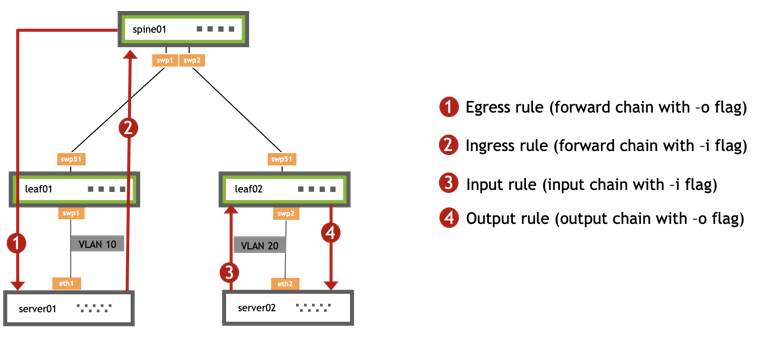
Egress Rule
The following rule blocks any TCP traffic with destination port 200 going through leaf01 to server01 (rule 1 in the diagram above).
[iptables]
-A FORWARD -o swp1 -p tcp --dport 200 -j DROP
Ingress Rule
The following rule blocks any UDP traffic with source port 200 going from server01 through leaf01 (rule 2 in the diagram above).
[iptables]
-A FORWARD -i swp1 -p udp --sport 200 -j DROP
Input Rule
The following rule blocks any UDP traffic with source port 200 and destination port 50 going from server02 to the leaf02 control plane (rule 3 in the diagram above).
[iptables]
-A INPUT -i swp2 -p udp --sport 200 --dport 50 -j DROP
Output Rule
The following rule blocks any TCP traffic with source port 123 and destination port 123 going from leaf02 to server02 (rule 4 in the diagram above).
[iptables]
-A OUTPUT -o swp2 -p tcp --sport 123 --dport 123 -j DROP
Combined Rules
The following rule blocks any TCP traffic with source port 123 and destination port 123 going from any switch port egress or generated from the switch.
[iptables]
-A OUTPUT,FORWARD -o swp+ -p tcp --sport 123 --dport 123 -j DROP
This also becomes two ACLs and is the same as:
[iptables]
-A FORWARD -o swp+ -p tcp --sport 123 --dport 123 -j DROP
-A OUTPUT -o swp+ -p tcp --sport 123 --dport 123 -j DROP
Layer 2 Rules (ebtables)
The following rule blocks any traffic with source MAC address 00:00:00:00:00:12 and destination MAC address 08:9e:01:ce:e2:04 going from any switch port egress or ingress.
[ebtables]
-A FORWARD -s 00:00:00:00:00:12 -d 08:9e:01:ce:e2:04 -j DROP
Considerations
Not All Rules Supported
Cumulus Linux does not support all iptables, ip6tables, or ebtables rules. Refer to Supported Rules for specific rule support.
ACL Log Policer Limits Traffic
To protect the CPU from overloading, Cumulus Linux limits traffic copied to the CPU to 1 packet per second by an ACL Log Policer.
Bridge Traffic Limitations
Bridge traffic that matches LOG ACTION rules do not log to syslog; the kernel and hardware identify packets using different information.
You Cannot Forward Log Actions
You cannot forward logged packets. The hardware cannot both forward a packet and send the packet to the control plane (or kernel) for logging. A log action must also have a drop action.
SPAN Sessions that Reference an Outgoing Interface
SPAN sessions that reference an outgoing interface create mirrored packets based on the ingress interface before the routing decision. See SPAN Sessions that Reference an Outgoing Interface and Use the CPU Port as the SPAN Destination in the Network Troubleshooting section.
iptables Interactions with cl-acltool
Because Cumulus Linux is a Linux operating system, you can use the iptables commands. However, consider using cl-acltool instead because:
- Without using
cl-acltool, rules do not install into hardware. - Running
cl-acltool -i(the installation command) resets all rules and deletes anything that is not stored in/etc/cumulus/acl/policy.conf.
For example, running the following command works:
cumulus@switch:~$ sudo iptables -A INPUT -p icmp --icmp-type echo-request -j DROP
And the rules appear when you run cl-acltool -L:
cumulus@switch:~$ sudo cl-acltool -L ip
-------------------------------
Listing rules of type iptables:
-------------------------------
TABLE filter :
Chain INPUT (policy ACCEPT 72 packets, 5236 bytes)
pkts bytes target prot opt in out source destination
0 0 DROP icmp -- any any anywhere anywhere icmp echo-request
However, running cl-acltool -i or reboot removes them. To ensure that Cumulus Linux can hardware accelerate all rules that can be in hardware, place them in the /etc/cumulus/acl/policy.conf file, then run cl-acltool -i.
Hardware Limitations
Due to hardware limitations in the Spectrum ASIC, BFD policers and the BFD-related control plane share rules. The following default rules share the same policer in the 00control_plan.rules file:
[iptables]
-A $INGRESS_CHAIN -p udp --dport $BFD_ECHO_PORT -j POLICE --set-mode pkt --set-rate 2000 --set-burst 2000
-A $INGRESS_CHAIN -p udp --dport $BFD_PORT -j POLICE --set-mode pkt --set-rate 2000 --set-burst 2000
-A $INGRESS_CHAIN -p udp --dport $BFD_MH_PORT -j POLICE --set-mode pkt --set-rate 2000 --set-burst 2000
[ip6tables]
-A $INGRESS_CHAIN --in-interface $INGRESS_INTF -p udp --dport $BFD_ECHO_PORT -j POLICE --set-mode pkt --set-rate 2000 --set-burst 2000 --set-class 7
-A $INGRESS_CHAIN --in-interface $INGRESS_INTF -p udp --dport $BFD_PORT -j POLICE --set-mode pkt --set-rate 2000 --set-burst 2000 --set-class 7
-A $INGRESS_CHAIN --in-interface $INGRESS_INTF -p udp --dport $BFD_MH_PORT -j POLICE --set-mode pkt --set-rate 2000 --set-burst 2000 --set-class 7
To work around this limitation, set the rate and burst for all these rules to the same values with the --set-rate and --set-burst options.
Where to Assign Rules
- If you assign a switch port to a bond, you must assign any egress rules to the bond.
- When using the OUTPUT chain, you must assign rules to the source. For example, if you assign a rule to the switch port in the direction of traffic but the source is a bridge (VLAN), the rule does not affect the traffic and you must apply the rule to the bridge.
- If you need to apply a rule to all transit traffic, use the FORWARD chain, not the OUTPUT chain.
ACL Rule Installation Failure
After an ACL rule installation failure, you see a generic error message like the following:
cumulus@switch:$ sudo cl-acltool -i -p 00control_plane.rules
Using user provided rule file 00control_plane.rules
Reading rule file 00control_plane.rules ...
Processing rules in file 00control_plane.rules ...
error: hw sync failed (sync_acl hardware installation failed)
Installing acl policy... Rolling back ..
failed.
INPUT Chain Rules
Cumulus Linux implements INPUT chain rules using a trap mechanism and assigns trap IDs to packets that go to the CPU. The default INPUT chain rules map to these trap IDs. However, if a packet matches multiple traps, an internal priority mechanism resolves them which can be different from the rule priorities. The default expected rule does not police the packet but another rule polices it instead. For example, the LOCAL rule polices ICMP packets that go to the CPU instead of the ICMP rule. Also, multiple rules can share the same trap, where the largest of the policer values applies.
To work around this issue, create rules on the INPUT and FORWARD chains (INPUT,FORWARD).
FORWARD chain rules can drop packets that forward through the switch. Exercise caution when defining these rules and be as specific as possible.
Hardware Policing of Packets in the Input Chain
Certain platforms have limitations on hardware policing packets in the INPUT chain. To work around these limitations, Cumulus Linux supports kernel based policing of these packets in software using limit or hashlimit matches. Cumulus Linux does not hardware offload rules with these matches, but ignores them during hardware install.
ACLs Do not Match when the Output Port on the ACL is a Subinterface
The ACL does not match on packets when you configure a subinterface as the output port. The ACL matches on packets only if the primary port is as an output port. If a subinterface is an output or egress port, the packets match correctly. For example:
-A FORWARD --out-interface swp49s1.100 -j ACCEPT
Egress ACL Matching on Bonds
Cumulus Linux does not support ACL rules that match on an outbound bond interface. For example, you cannot create the following rule:
[iptables]
-A FORWARD --out-interface <bond_intf> -j DROP
To work around this issue, duplicate the ACL rule on each physical port of the bond. For example:
[iptables]
-A FORWARD --out-interface <bond-member-port-1> -j DROP
-A FORWARD --out-interface <bond-member-port-2> -j DROP
SSH Taffic to the Management VRF
To allow SSH traffic to the management VRF, use -i mgmt, not -i eth0. For example:
-A INPUT -i mgmt -s 10.0.14.2/32 -p tcp --dport ssh -j ACCEPT
INPUT Chain Rules and swp+
In INPUT chain rules, the --in-interface swp+ match works only if the destination of the packet is towards a layer 3 swp interface; the match does not work if the packet terminates at an SVI interface (for example, vlan10). To allow traffic towards specific SVIs, use rules without any interface match or rules with individual --in-interface <SVI> matches.